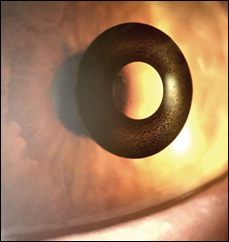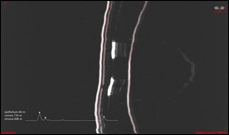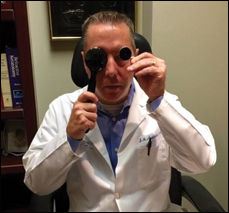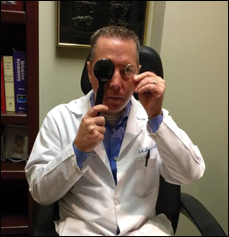Corneal inlays provide another option for presbyopes
This optometrist stresses the importance of patient selection and strict compliance with the Kamra inlay.
Presbyopia is a dynamic, age-related disability for many people. Worldwide, more than 1 billion people have presbyopia, and by the year 2020 that number is expected to exceed 1.37 billion, according to Holden.
The exact biological mechanism of presbyopia is not fully understood. There are several theories of etiology, including age-related loss of the flexibility of the natural lens, loss of capsule elasticity, loss of proper ciliary body and zonular fiber function, and subtle changes in the anatomical positioning of the lens relative to the ciliary body.
Today’s nonsurgical treatment options include bifocal and monovision contact lenses, reading glasses and traditional bifocal spectacles. Surgical options include laser vision correction to produce monovision, refractive clear lens exchange with a monofocal intraocular lens targeted for monovision and multifocal IOL.
Two newer technologies that recently have been approved include the Kamra inlay (AcuFocus, Irvine, Calif.) and the Raindrop Near Vision Inlay (ReVision Optics, Lake Forest, Calif.).

The Kamra inlay, approved by the FDA in April 2015, is opaque with an overall diameter of 3.8 mm and a small central annulus of 1.6 mm that acts as a pinhole. The small aperture increases the patient’s depth of focus, improving both near and intermediate distances, while only minimally affecting distance vision.
This inlay is composed of polyvinylidene fluoride and is 6 microns thick (about 15 times thinner than a piece of paper), with 8,400 microperforations arranged in a random pattern that help maintain corneal metabolic flow.
The surgical procedure takes only about 10 minutes and utilizes a femtosecond laser to create a 250- to 300-micron pocket into the corneal stroma. The use of the femtosecond laser provides for more corneal biomechanical stability and reduces the incidence of dry eye compared to a traditional LASIK lamellar flap.

Images: Augustine J
The Kamra inlay can be surgically implanted in eyes that have previously undergone LASIK. For safety, the inlay needs to be placed at least 100 microns below the original LASIK flap. Corneal analysis using the ArcScan Insight 100 System (ArcScan Inc., Golden, Colo.) or anterior segment OCT can help determine previous LASIK lamellar flap thickness.
All corneal inlays are placed in the nondominant eye. For the Kamra inlay, the optimal preoperative refractive error is -0.75 D with less than -0.50 D of astigmatism. In most Kamra cases, the patient needs to have LASIK or PRK to optimize the “sweet spot,” the refractive error target of -0.75 D prior to implantation of the inlay.

The optics of the Kamra inlay aperture functionally extend the depth of focus on both sides of plano, “correcting” both plus and minus refractions. Thus, the target Rx of -0.75 D is placed in the middle of the depth of focus range, bringing in the distance vision and also correcting presbyopia and bringing in the near vision. If you start with plano, you are using up a portion of the depth of focus, functionally cutting it in half. A potential hyperopic healing response would further compound the depth of focus so the patient would simply see at distance.
Patient selection
Patient selection is critical for optimal results. The Kamra inlay can be used in natural emmetropes as well as those who have previously undergone LASIK and PRK depending on overall residual corneal and flap thickness. A variety of patient populations can benefit from this technology, including pseudophakic monofocal patients.
Clinicians should consider patients in their mid-40s or 50s who are emmetropic or have only mild myopic, hyperopic and astigmatic refractive errors. Good candidates are often professionals who perform a great deal of near work, are often frustrated with their need for reading glasses and do not like the idea of monovision laser vision correction. Unlike laser vision-corrected monovision, the results of the Kamra inlay do not significantly affect distance vision. Patients retain excellent binocularity, have less anisometropia and retain excellent stereopsis.
The patient considering corneal inlays should also have good overall systemic and ocular health. They should have no medical contraindications such as diabetes, rheumatoid arthritis or any type of autoimmune disease. The inlay patient needs to have a healthy ocular surface and no significant lenticular opacities, because the Kamra inlay requires extremely good optics due to the nature of the small aperture. With the inlay in place, the patient sees through a 1.6-mm aperture at the central apex of the cornea. Should the ocular surface be compromised, vision will likely be compromised. Therefore, if any dry eye issues are present, they should be resolved prior to the procedure.
The patient’s objective scatter index (OSI) – the visual quality of the cornea and lens – should be analyzed with the AcuTarget HD instrument (Visiometrics) preoperatively and postoperatively. A high OSI means more scattering of light and poorer visual quality. This helps the clinician determine the severity of the dry eye and the potential for significant lens opacification. Optimization of the ocular surface with pharmaceuticals, punctal occlusion or nutritional products prior to surgery will help ensure better visual outcomes.
Complications associated with the Kamra inlay are similar to other refractive surgical procedures, but the big advantage with the Kamra inlay is that it is reversible. Potential complications include: abnormal wound healing response, decentration of the inlay, refractive error shifts and chronic dry eye.
Patient education
Patients and clinicians are aware of the current limitations of laser-created monovision, including decreased distance vision, anisometropia, loss of stereopsis and decreased binocular function. Accommodation is a dynamic age-related process that changes with time. When a patient undergoes monovision laser vision correction, we know that the refractive result, for some, has a limited shelf life. While some patients may initially be happy with laser vision-corrected monovision, as they age, they may inevitably need to contemplate an additional surgical or optical solution to maintain good functional near vision.
The Kamra inlay is essentially age-independent, as it continues to work despite the progressive loss of accommodation, due to the small aperture (or pinhole effect). Regardless of other ocular age and related pathologies, theoretically, the patient will not lose their distance and near vision as the eye ages. Surgically, we may no longer have to chase the loss of monovision with additional laser vision correction.
Preoperatively, the surgical results can be demonstrated to patients with a pinhole occluder. Place it over the patient’s nondominant eye to demonstrate near and distance uncorrected vision. Cover the dominant eye and have the patient appreciate the vision through the pinhole at both distance and near. Then demonstrate monovision laser vision correction by placing a +1.50 D trial lens over the nondominant eye and cover the dominant eye, having the patient look at both distance and near. The distance vision will be compromised. This gives the patient a clear understanding of the possible results and the positive and negative aspects of monovision laser correction versus the Kamra inlay. Multifocal contact lenses can also be used to demonstrate this.
Recovery expectations
Unlike a LASIK or cataract procedure, vision tends to recover slowly. Optimal uncorrected distance and near visual acuity typically comes between 4 and 8 weeks postoperatively. In general, hyperopic patients experience improved vision sooner and are extremely happy early on. However, myopic patients tend to take a bit longer to adapt. During consultations, emphasize the healing process and the amount of time it may take.
We perform simultaneous LASIK and Kamra inlay implantation on the majority of our patients without affecting healing time. In addition, the combined surgery is a much-appreciated convenience for the patient.
In our practice, postoperative drops are typically recommended for up to 6 months. The patient will administer antibiotic drops four times a day for a week. A strong steroid, such as prednisolone, is recommended four times a day for the first week, three times a day the second week, twice a day the third week and once a day the fourth week. Then the patient will use a mild topical steroid four times a day for the fifth week, three times a day for the sixth week, twice a day for the seventh week, and once a day for the eighth week and the next 4 months.
Postoperative evaluations are conducted at day 1, week 1, 1 month, 2 months, 4 months, 6 months and 1 year. At each visit we check uncorrected near visual acuity, uncorrected distance visual acuity, manifest refraction spherical equivalent, ocular surface index, tear film index, centration and topography. Centration is critical. A superior decentration has a much greater impact on loss of best-corrected visual acuity. The earlier the detection of decentration the better for inlay repositioning. For all follow-up appointments, the AcuTarget HD is used to assess dry eye. It is also important to monitor the intraocular pressure, watching for steroid response.

The autorefractor is unreliable in a Kamra inlay-implanted eye. When taking a refraction, it works best to utilize the red-green refraction technique. The Kamra inlay is a refractive-neutral device; assuming all healing is within normal limits, the patient’s preoperative refraction should match their postoperative refraction.
During these postoperative visits, continually manage expectations and patient compliance as it relates to the use of topical medications. It is important to note the consistency of the visual acuity measurements. The examination can be aided with the use of the near point rod and by optimizing room lighting. A healthy ocular surface is essential for patients to maintain good constant visual results. Corneal hydration is paramount.

This is a relatively new procedure in the U.S., and maintaining tight control of the process is advisable. Clinically, we have had few issues with the use of the Kamra inlay due to our emphasis on proper patient selection and compliance. While the number of follow-up visits may be burdensome, the clinical data obtained has enabled us to better direct and understand the postoperative care and treatment of the Kamra patient. Patients appreciate the attentive professional care. We have found the postoperative patient encounters to be significantly beneficial to the patient’s satisfaction and visual results.
Results
The results of the Kamra inlay in our practice have been exciting, and our studies show improvements in near and intermediate vision and no significant loss of distance vision. Our 6-month data on 140 eyes show that 60% of treated eyes have uncorrected near acuity of 20/20, and 62% of treated eyes have an uncorrected distance acuity of 20/20.
Corneal inlays are a new treatment option for the presbyopic patient with some distinct advantages over prior surgical options. It is exciting to be a part of this new paradigm shift for the treatment of presbyopia.
- Reference:
- Holden BA, et al. Arch Ophthalmol. 2008;126:1731-1739. doi: 10.1001/archopht.126.12.1731.
- For more information:
- Jeff Augustine, OD, practices at Clear Choice Custom LASIK Centers in Brecksville, Ohio. He can be reached at jmaugustine4@gmail.com.
Disclosure: Augustine is a consultant for AcuFocus.



